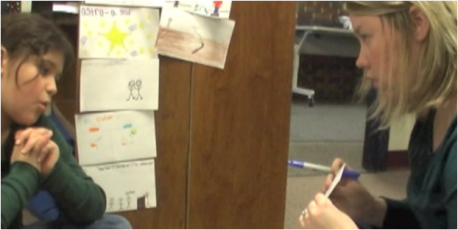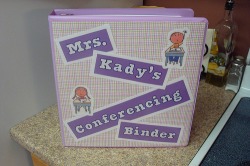Differentiation Made Easy:
Teaching with a Workshop Approach
Teaching with a Workshop Approach
Conferencing
"We launch writing workshops in our classrooms because the writer's workshop is a structure that allows us to teach students individually in conferences, even in classrooms that contain thirty or forty students. Writing conferences aren't the icing on the cake, they are the cake." Carl Anderson, How's It Going?, p. 3
As teachers we often overlook this point Carl Anderson makes in the quote above. However, once we read it, we can't ignore it. This portion of the workshop classroom seems to be the part that teacher's have the most struggles with. What is the right way to conference? How often? How do I have time to sit with one child and what are the other students doing? Really, the whole purpose of setting up your classroom to run in a workshop format is so you can conference individually with students or work in small groups. When you meet individually with your students, you are differentiating your instruction!
What is a conference?
Undoubtedly as a teacher you have had parent/teacher conferences, but this is the kind of conference between student and teacher. A conference is simply a conversation between two people. One person listens while the other talks, then the roles are reversed. This is all a conference really is between student and teacher. In the beginning, the teacher is the listener and the student is the talker. Then, the roles switch, where the student listens and the teacher talks.
What is the structure of a conference?
Step 1: Ask a Question
I usually say, "How's your reading/writing going?
Step 2: Listen & Point Out A Positive
Listen to the child read some of their writing or a page from a book they are reading. Point out one thing they did really well while you were listening.
Step 3: Pick a Strategy
You can select a strategy to teach or have the child tell you something they want help with.
Step 4: Teach the Strategy
Teach the child ONE strategy to work on. There might be a million things the child needs help with, focus on one thing to help the child with. Model the strategy how you would use it, and have the child try it out.
Step 5: End with a Smile, Praise and Record What Was Taught
Leave on a positive note and record what you taught the child. I use a binder with information on my students.
I usually say, "How's your reading/writing going?
Step 2: Listen & Point Out A Positive
Listen to the child read some of their writing or a page from a book they are reading. Point out one thing they did really well while you were listening.
Step 3: Pick a Strategy
You can select a strategy to teach or have the child tell you something they want help with.
Step 4: Teach the Strategy
Teach the child ONE strategy to work on. There might be a million things the child needs help with, focus on one thing to help the child with. Model the strategy how you would use it, and have the child try it out.
Step 5: End with a Smile, Praise and Record What Was Taught
Leave on a positive note and record what you taught the child. I use a binder with information on my students.
What do you teach in a conference?
Undoubtedly, you will notice when you work one-on-one with students that there are many options of what you can teach them to become better writers. The key is to focus on one, maybe two at most, strategies that will help them in any writing piece or any book they might be reading. In the video clip below, Portalupi and Fletcher remind us of the importance of just connecting with our students and appreciating and really responding to our writers:
Below is an example of a reading conference in action.
How long to conferences last?
Really, conferences should last between 3-5 minutes per student. At first, your conferences might be a little longer, but really there is a give and take between talking and listening in a conference, so you should be mindful that conferences are brief but important interactions between you and the student. Also, it is easier to stick to about 5 minutes when you are only teaching one strategy for the student to use in their reading or writing.
What if my student is a really good writer or reader? What do I conference with them about?
Of course you might have some students who are further along, but as their teacher, they deserve to be pushed along to raise the bar of excellence in themselves. After all, this is really at the heart of differentiation. In the video clip below we see how one teacher raises the bar for their student in a writing conference. In a reading conference, I would push my student to look at different genres or more difficult texts.
How often do you conference with students?
Really, you can conference with about 5 students a day. If you have a larger class, you could meet with each student once every two weeks. In a smaller classroom setting, you could meet with each student once a week individually. However, keep in mind that you'll want to meet with your struggling students most often, because that is what is fair for those students. They need you the most to help them move along.
In writing, I have a spot on my board where I write the names of 3 students whom I have selected to conference with for the day. Then, there are two blank spots for students to sign up for a conference with me. I learned that it is good to have a balance in the writer's workshop of teacher designated conferences and student selected.
In writing, I have a spot on my board where I write the names of 3 students whom I have selected to conference with for the day. Then, there are two blank spots for students to sign up for a conference with me. I learned that it is good to have a balance in the writer's workshop of teacher designated conferences and student selected.
How do you keep track of your conferences?
I keep a binder with all the conference information about each student. I have numbers for each of my students, which helps when grading. I use numbered tabs in my binder for information about each student. So if I am conferencing with Jimmy, and he is number 4, I would go to the tab numbered 4 when I conference with him. I used Avery Ready Index Tab Dividers, which are already numbered, and can be used year after year. In the beginning of the year, you might want a table of contents which lists what number each student is until you get to know your students and numbers by heart, which happens after the first few weeks of school.
The two sisters recommend that your binder be personal to you and be unique so you can find it easily if you set it down in between teaching and conferencing. Also, this way the kids will know it is your binder. I wouldn't recommend a plain white binder, it will look like everyone else's. However, if you aren't into arts and crafts you can easily print out a piece of paper to insert into the binder cover which you could include pictures of things you like. Or, if you want to go really wild you can create your own special binder on the website Zazzle. You can goggle the words "Zazzle Binder Coupons" and find a coupon to knock off the price of the binder, too!
The two sisters recommend that your binder be personal to you and be unique so you can find it easily if you set it down in between teaching and conferencing. Also, this way the kids will know it is your binder. I wouldn't recommend a plain white binder, it will look like everyone else's. However, if you aren't into arts and crafts you can easily print out a piece of paper to insert into the binder cover which you could include pictures of things you like. Or, if you want to go really wild you can create your own special binder on the website Zazzle. You can goggle the words "Zazzle Binder Coupons" and find a coupon to knock off the price of the binder, too!
In each students tab divider I have a writing conference sheet and reading conference sheet and a copy of the CAFE menu. Each student also can have a copy of a goal sheet and CAFE menu for their own binders.
| reading_conferencing_sheet.doc |
| writing_conferencing_sheet.doc |


